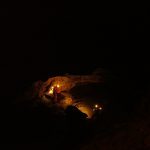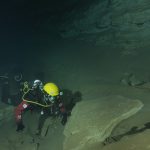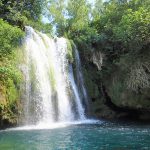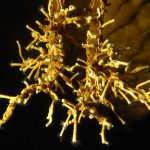Speleothems – cave ornaments
The formation of speleothems is part of the karstification process that creates caves and pits.
The word speleothem, or cave deposit, comes from the Greek words sphlaion or spelaion meaning cave or pit, and thema meaning deposit.
Speleothems are secondary mineral deposits that form underground, in caves and pits. They are created through the action of water, and may contain one or a combination of more than 300 minerals. The most common cave minerals in Croatian caves are calcite, aragonite and ice. Calcite and aragonite account for about 95% of all cave minerals. The concept of speleothem does not in itself represent the minerals, instead it relates to the specific manner in which these minerals appear in caves and pits. For example, the mineral calcite is not a speleothem, though a calcite stalactite in a cave is. Therefore, speleothems are built of minerals, and a wide variety of minerals can make up a certain type of speleothem.
Calcite speleothems are most common and the most significant deposits in most caves. As they grow, they can also incorporate many other minerals, dust from the air and organic materials, from spores to pollen grains, even bones.
Speleothems are classified above all by their shape, and by the way they are formed (dripping water, water pouring over walls, splashing, crystal growth on the surface of a lake, deposition in underwater areas, etc.). Certain types of speleothems have received names based on their morphology, such as cave pearls or curtains, or based on the environment in which they were formed, e.g. calcite rafts or underwater speleothems.
To date, 38 different types of speleothems have been defined worldwide, some of which are exceptionally rare. The most common and certain rare types of speleothems that can be found in the Croatian karst are stalactites, stalagmites, columns, curtains, helictites, moonmilk, cascades, crystals and flowstones.
Stalactites are the best know type of speleothem. They grow (hang) from the ceiling down towards the floor. The size, shape, texture and composition of the stalactite surface is the result of numerous factors: drip rate, air circulation, evaporation, humidity, temperature, solution concentration, hydrostatic pressure, partial CO2 pressure in solution and in the cave atmosphere. The water penetrating through fissures in the rocks collects on the cave ceiling in the form of a thin film or drops. When a drop becomes too heavy, it falls, and the carbon dioxide inside is released, leaving a fine calcite ring along its edges, which is initially bound to the ceiling through surface tension. This is the initial ring, and the start of the future tube. The tube continues to grow as long as there is a continuous flow of water, and its diameter is determined by the diameter of the water droplet. The oldest part of the stalactite is the central part, while the outer layers are youngest, including the tip. In cross section, it is possible to differentiate the older from younger layers of the stalactite, similar to reading tree rings. However, individual layers most often do not correspond to seasonal climatic changes (summer/winter) as in trees, but are instead formed in much larger, irregular intervals.
Stalagmites are speleothems that grow upwards from the cave floor. They vary widely in shape, and are formed from the dripping of water off the ceiling or off a stalactite directly above it. They typically have a rounded tip, and a larger diameter than the accompanying stalactite above. Unlike stalactites, stalagmites do not have a central canal.
When a stalagmite grows so much that it becomes connected to the stalactite, a column is formed, and such columns may grow to enormous size.
Flowstones are very common speleothems. They may vary in shape, depending on the surface on which they are formed. Flowstones are formed from the slow flow of a thin layer of water over a broad surface, where CO2 is released from the solution into the air, leaving the calcite to crystallise. These crystals continue to grow, with a general orientation perpendicular to the surface of the flowstone. The flowstone grows in thin layers, which can be many different colours, depending on the changes to the composition of the solution from which the crystals are deposited.
Ice speleothems are created by the freezing of dripping, flowing and percolating water, and water vapour from the cave air. The freezing dripping and flowing water creates forms like ordinary calcite speleothems: ice stalactites, stalagmites, columns, curtains and flowstones. Ice speleothems typically have a smooth surface, and rarely have visible ice crystal surfaces. Thin ice speleothems are transparent, while thicker ones take on a white, dark blue or blue-green hue.
Speleothems are used in paleoclimatic research. Paleoclimatology is the scientific discipline that studies climate change throughout the past. Information of these changes are recorded in the physical, chemical and organic properties of the speleothems. The cross-section of speleothems enables reconstruction of former climate conditions, and can provide answers to the questions of the spatial and temporal variability of climate, and of the speed of and causes behind natural climate change.














